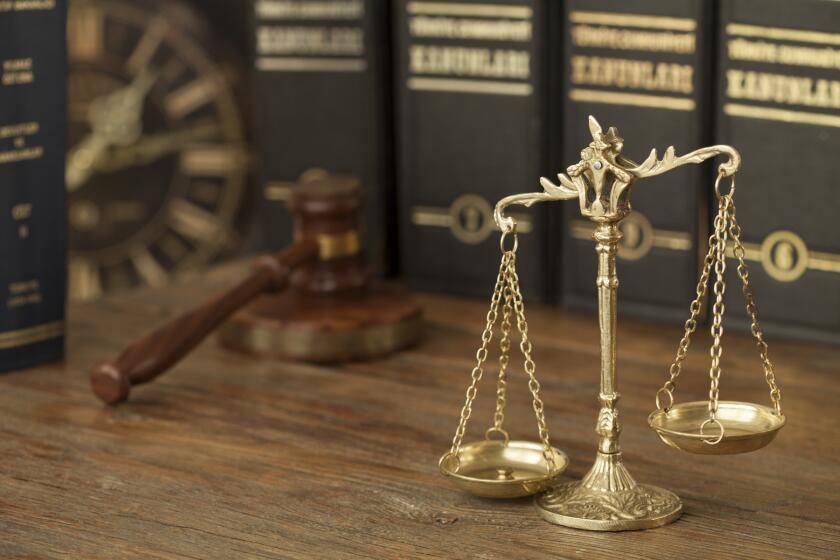Some artists get easily abstracted
- Share via
BOBBIE ALLEN
The philosophy of representation in art usually boils down to a
single question: to abstract or not to abstract. The term
“abstraction” in art is commonly misunderstood, sometimes taken to
imply “vague,” or even “obscure.”
But artists who became abstractionists were aiming at purity. They
were turning their backs on painting methods that had become more and
more photographic, deciding to express the inner qualities of a
subject by choosing its most recognizable characteristics only,
leaving out detail that identified an individual thing.
Eventually, this moved to the extreme expression of the most
“abstracted” states of being (now used in the sense of “pulled away
or removed from particulars”). Mark Rothko, an artist of the New York
School most prominent during the 1940s and 50s, produced large-scale
blocks of color, multi-layered with incredible luminosity and depth
-- colors that produced sublime experiences in the viewer. He
expressed abstractly.
But when the artist chooses to directly represent a subject, he or
she may use the opposite gesture: the subject may be radically
idealized. You could call this the Platonic impulse in art, familiar
since the ancient Greeks. Rather than sculpt this particular woman,
the sculptor would “abstract” proportions of arms, legs, facial
features to represent the perfect human figure. This is the source of
our admiration: impossible beauty.
From that has sprung the question, now thousands of years old,
that every artist must answer: How do I represent this subject?
Two artists currently on view at William Merrill Gallery (611 S.
Coast Highway) answer the question in strikingly different ways.
Southern California painter Paul Ecke is exhibiting large, high
relief canvases he is calling “Quadrants.” Like Rothko, Ecke is an
abstract expressionist. The canvases are all, in a way, color studies
designed to evoke certain emotional or intellectual connections on
the part of the viewer.
The canvases are all built up from gesso, sand, found objects
(chiefly large washers), and many layers of paint. They have a stucco
quality, almost sculptural.
This makes Ecke’s large canvases mutually complementary with the
sculptures of Dan Corbin. These are scattered throughout the gallery.
They are all idealized nudes, both male and female, smaller than life
size. They are headless, sometimes armless -- this makes them
immediately referential to Greek sculpture (which of course wasn’t
sculpted that way: the limbs and heads broke off or were stolen).
Corbin, too, uses found objects, integrating them into bronze,
steel or aluminum torsos and standing figures. Corbin, however, works
with the surface of the metal in such a way that it takes on the
quality of stone or a painted surface.
As soon as you enter the gallery, you are faced with this
radically different yet remarkably similar philosophy. Ecke’s large,
four-canvas work, “Four Voices” (72x96) is flanked by two of Corbin’s
sculptures. Ecke’s work is simple, linear, composed of deep layers of
burnished browns and taupes. The outside edges of the canvases are
darker than the middle sections, and the bottom two canvases have
even darker horizontal sections. This gives them a fractured,
fragmented quality, already present in the four separate surfaces.
These surfaces appear to have been raised, carved, and sanded, giving
them a similar surface to Corbin’s metal.
Corbin’s sculptures pick up the same tonal ranges as Ecke’s
canvases. “Today’s Pharaoh,” a 62-inch male nude, and “Integrity and
Honor” (female, 56 inches) look as if they were removed from a
temple. Both are in French bauxite (a type of aluminum), but surfaced
with riveted metal plates, inlayed resin or imprinted with various
industrial materials. The seams or flashings from the mold are
emphasized in both works. The overall effect is a that of a modern
Pygmalion fashioning the perfect human form by integrating industrial
objects. They are artifacts before their time.
“Icon,” a 23-inch female torso, is surfaced in sections. One
shoulder is the bare bronze. Another seems to have a “skin” that
reveals rib-like bumps beneath it. Her proportions are slender and
graceful, a modern ideal. Yet she is fragmented in sections that
grant her an inner, mechanical life.
The same might be said of the washers that are symmetrically
placed in the sections of Ecke’s 48x48 canvas, also called “Four
Voices.” Here, the earth tones mix with reds and a verdigris patina,
as if this were a bronze canvas that had weathered. The ideal that
Ecke is reaching for is found within the viewer, the evocative
qualities of color, referring to form secondarily. Corbin evokes with
form, and refers to color to shift the viewer disconcertingly off
surface perfection.
Rothko once wrote that his goal was to remove all obstacles
“between the idea and the observer.” You could call this a kind of
reformed idea of art, where the source of the narrative -- the story
a piece tells -- comes from the viewer. That is how “abstraction”
expresses. But he also saw this as the opposite of “perfection,”
which is surface-obsessed, de-individualized and cold. Corbin has
avoided the trap of the ideal, in the same way Ecke has embraced it.
* BOBBIE ALLEN is a poet and writer who has taught art theory and
criticism. She currently teaches writing at the University of
California, Irvine.
All the latest on Orange County from Orange County.
Get our free TimesOC newsletter.
You may occasionally receive promotional content from the Daily Pilot.



